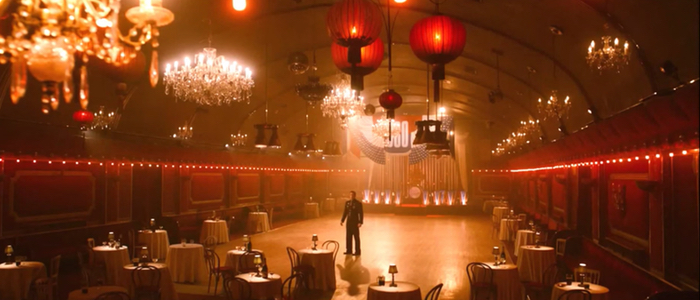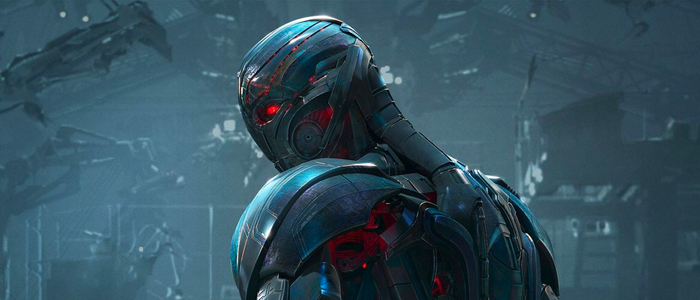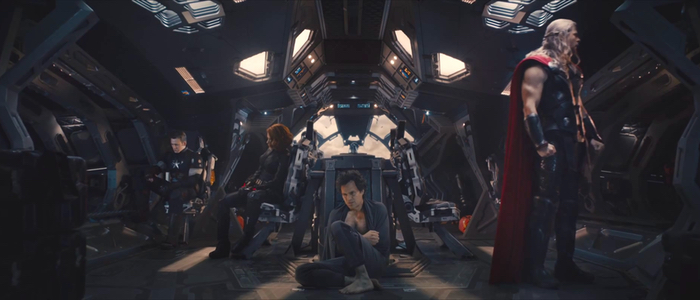(Welcome to The Unpopular Opinion, a series where a writer goes to the defense of a much-maligned film or sets their sights on a movie seemingly beloved by all. In this edition: why Avengers: Age of Ultron is actually superior to the other Avengers films.)
What do we want from the Marvel Cinematic Universe? Do we merely want a collection of cool moments; the realization of decades upon decades of comic book splash pages brought to digital life on a big screen with booming surround sound? Do we want the joy of recognition; the giddiness that comes when a familiar easter egg appears and we knowingly elbow whomever we’re seeing the movie with, as if to say, “I recognize that; do you?” Or do we want something challenging? Something that takes the raw materials that make up the MCU and builds them up into something entirely unexpected?
Better yet – what if we could have all of those things, together? As it turns out, we did. It was called Avengers: Age of Ultron. And people weren’t happy about it.
“Can These People Actually Stand Each Other?”
Let me be clear up front : Age of Ultron isn’t some misunderstood masterpiece. It’s not even a universally reviled film – it sits at 75% “Fresh” on Rotten Tomatoes, which isn’t that bad. But the reaction to Age of Ultron upon release was not what one would call overwhelmingly positive. Part of this had to do with hype – the excitement for the sequel reached a fever-pitch; a sort of mania set in, heightened even further when the trailer for the film unexpectedly leaked online ahead of schedule.
Yet so fierce was the backlash following release that it (allegedly) was the cause of director Joss Whedon fleeing Twitter (he later returned). And then there were behind-the-scenes rumblings. In several interviews for the film, Whedon sounded exhausted and defeated. He’d later go so far as to say that he came off of Ultron “feeling like a miserable failure.” It marked the end of his association with the MCU. Perhaps that was for the best. Because Whedon, for all his flaws, clearly had a much different vision for his Marvel films than Marvel did. And those differences were irreconcilable. After Whedon left, the MCU sequels became slightly more rote; more predictable. And also more fun.
And perhaps that’s Age of Ultron’s ultimate sin. It’s not really interested in having fun. It is, perhaps, a hold-over from an earlier comic book movie age – when filmmakers were still trying to deconstruct superhero myths rather than build them up. But audiences were slowly but surely learning by the time Age of Ultron opened in 2015 that they didn’t want to see their heroes torn down. They wanted them to excel; to be beacons of endless, shining hope. To be flawless.
Whedon’s first Avengers film is an achievement unto itself. I’m not talking quality-wise – there’s a lot of creakiness in the first Avengers, and there are still plenty of early MCU growing pains baked into the narrative. But there really hadn’t ever been a movie like The Avengers. Marvel had spent a few years building up their heroes, and then finally brought them all together for a huge cinematic event. It had audience’s enraptured. It helped that the film itself was a heck of a lot of fun – the type of big, loud popcorn movie that the masses crave, full of the type of quips Whedon’s work is known for, as well as huge special effects sequences. It was spectacle in its purest form. How does one follow it up?
Marvel and Whedon could’ve gone the Die Hard 2 route, perhaps: crafted the same exact movie with a few changes here and there. But Whedon wanted to do something different. “We get to pull them apart as much as we put them together,” he said. “Obviously they’re still the Avengers and we hope that they’ll save the day. But I think of movies like Empire Strikes Back or The Godfather: Part II, where you get the same kind of movie, but something deeper, more personal. You get the same kind of movie that you loved, but you see a level beneath that, some sort of darkness.”
After having brought the team together in Avengers, Whedon set about tearing them apart in Age of Ultron. “Once you have your ‘origin of a team’ story, you want the next story to be really about, ‘Well can that paradigm sustain?’” he said. “‘Can these people actually stand each other…?’…We get to get further into the heads of all the characters and see why they work as a team and why they don’t, and the mistakes they are going to make and the solutions they are going to come up with.”
Earth’s Mightiest Monsters
What might throw people for a loop is the way Whedon views the Avengers: in his script, they’re monsters. He believes this so firmly that he has several characters proclaim themselves to be monsters, over and over again. He even has Tony Stark (Robert Downey Jr.) take Bruce Banner (Mark Ruffalo) aside and remind him that they’re “mad scientists.” The Avengers are a group of super-powered killing machines, and what’s more, they all know it. Age of Ultron asks: what if someone else caught on to this fact as well?
That someone ends up being Ultron, the bratty, sarcastic killer robot that Stark and Banner accidentally create. Stark, still suffering from PTSD from the events of the first Avengers, has made world safety his number one priority. He wants to put a “suit of armor around the world.” And so he’s developed the Ultron global defense program. In true Frankenstein-fashion, Tony’s creation becomes something dangerous and destructive. Ultron becomes sentient, and builds itself a big, bulky, super-strong robot body. And that body just happens to have the voice of James Spader.
Marvel gets a lot of guff for its lackluster villains, and rightfully so. But Spader’s Ultron is an absolute hoot. He’s a deranged, quippy mad philosopher, and Spader’s soothing-yet-raspy voice goes a long way to making him memorable. He’s the type of villain who severs an arm and then awkwardly and quickly apologizes. He’s also convinced he’s right – how could he not be, he’s super smart, after all! He’s like a sarcastic HAL 9000 from 2001: A Space Odyssey. He’s prone to spouting biblical verse of the doomsday variety, and he has a plan: destroy the world to save it from the Avengers. No one would argue that this plan makes any sense – but does it have to? Do we really need our crazy killer robot bad guys to make sense?
Maybe we do. And maybe there is a version of Age of Ultron where a lot more makes sense. When watching the film, it’s clear that even at 141 minutes, Age of Ultron is a truncated version of a much longer movie. There’s a lot missing, most noticeably when it comes to Thor. You get the sense that Whedon doesn’t much care for Thor, and I can’t say I blame him for this decision at the time. Thor didn’t really come into his own until Thor: Ragnarok, despite Chris Hemsworth’s best efforts.
Age of Ultron’s plot gives the Avengers two other main antagonists besides Ultron: war orphans Wanda and Pietro Maximoff, who hold Tony Stark and his former life as a weapons manufacturer personally responsible for their parents’ deaths. It has to be said: these characters don’t really work. They’re visually appealing: Pietro, AKA Quicksilver, zooms around like Sonic the Hedgehog, and Wanda, AKA Scarlet Witch, can levitate objects with red mist, and also get into people’s minds. Aaron Taylor-Johnson plays Pietro, and his role is mercilessly small enough that his bland acting doesn’t get in the way. The same can’t be said for Elizabeth Olsen, playing Wanda. Wanda has become a full-fledged Avenger at this point, showing up in multiple sequels, but one gets the sense that Olsen, normally a good actress, is very, very bored with the part. It doesn’t help that the role requires her to constantly wave her hands around like she’s auditioning for Bob Fosse.
In short, these characters are dull. But they inexplicably give Age of Ultron some of its most powerful moments. Pietro’s death at the end of the film is surprisingly resonate, mostly due to how Jeremy Renner, as Hawkeye, reacts to the death with a real sense of sorrow.
Wanda, meanwhile, uses her powers to gets into the heads of Earth’s Mightiest Heroes one by one (save for Hawkeye, who had to do the whole mind control thing in the last movie, and thus is spared this go around). Working her magic, Wanda is able to make the Avengers experience their biggest fears. These dream-like visions are some of Age of Ultron’s most stunning sequences, and visually superior to most moments in future MCU films.
Tony Stark, always pushing people away with his inherent jerkiness, is actually terrified at the idea of losing everyone. He has visions of his fellow Avengers scattered about the ground, dead.
Black Widow relives her traumatic past: the events that turned her into an assassin, being trained by Julie Delpy at what looks like a ballet school from hell. We see her brutally gun down a whimpering, hooded man without a second thought.
Thor is transported to a banquet hall on Asgard, and accused of abandoning his people for death.
We don’t get to see what’s going on in Bruce Banner’s mind, but we do see what Wanda’s work does: it unleashes the Hulk, who proceeds to go on a mad rampage.
And then there’s Steve Rogers, AKA Captain America (Chris Evans). Cap is the square of the group. The film even opens with a hilarious joke where Cap reprimands Tony for swearing – a joke that becomes a recurring bit throughout the film. Yet no matter how pure and good Captain America may seem, he’s also a walking, talking science experiment. He’s a former pipsqueak genetically altered to be a weapon of war. At one point in the film, S.H.I.E.L.D agent Maria Hill says, “We’re not at war, Captain.”
But in the 21st century, America is always at war. And we seemingly always will be – caught in the midst of wars without end. Steve’s vision transports him to a USO show, seemingly at the end of World War II. As he wanders through the sea of laughing, dancing soldiers, he’s still seeing (and hearing) war everywhere – camera flashbulbs sound like bombs going off; a soldier is on the floor with wine spilled on his shirt, but the spill has taken the shape of a bullet hole. Steve eventually bumps into his lost love, Peggy Carter – ready at last for that dance he promised her in Captain America: The First Avenger. “The war’s over, Steve!” she proclaims. “We can go home. Imagine it!”
Steve can’t imagine it. Peggy vanishes. The war is never over.
Continue Reading Age of Ultron Defense >>
The post The Unpopular Opinion: ‘Age of Ultron’ is the Best and Most Interesting ‘Avengers’ Film appeared first on /Film.
from /Film https://ift.tt/2HugMGb



